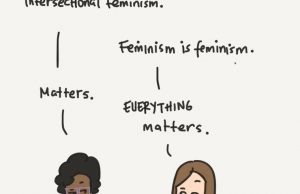I Ain't Your Girl: Controlling Identities and Acts of Isolation in the Academy
By Shannon Gibney & Anonymous
Throughout this essay, the pronoun “we” is used, in order to mark experiences shared by both authors. When the narrative shifts to the “I” perspective, it conveys the sole experience of the primary author, Shannon Gibney.
I.
Can we ever be healthy in a system in which we are not seen?
Obscured.
Ignored.
Misshapen.
Maligned, even?
We offer up this question not because it needs to be answered, but because it needs to be asked.
II.
I can burrow my lips into my son’s shock of black curly hair every evening after I return from school, laughing at his squealing delight. I can diligently go for my evening run through my neighborhood or at the gym, pounding fleeting images and whispers of an administrator’s negative assessment of my teaching performance into the ground. I can even spend time at the pristine Meditation Center just down the road, refocusing my mind on my breath with each inhale. But late at night, lying in my bed, considering a colleague’s blithe dismissal of my critical analysis of the whitening of our students’ journey through the Western arc of our college-level English courses, I realize that perhaps I am not really there. As a woman of color, even after a decade in the 21st century, I am rendered invisible.
III.
After all, the only places where we feel seen at academic institution are in the classroom with our students and in the offices and company of the handful of other women of color faculty and white allies. Once we step outside of these too few safe and comforting spaces, we never know what we will find, and if we are even more honest with ourselves, what we usually find are processes, policies, and procedures that work to the detriment of our intellectual, emotional, and physical health as women of color faculty.
IV.
We are two tenured women of color colleagues, soul-friends, fellow artists and organizers, who were surprised to find ourselves at an urban college in the Midwest. The college boasts of its diverse student demographic, but like most educational institutions in the U.S., is struggling to close and explain its disparity gaps among students of color and faculty of color. One of us is biracial, growing up in a predominantly white, middle-class community and family, and the other is first-generation college-educated and working-class, from a large metropolitan northern city. We are both in relationships with men who are recently naturalized citizens, and both of us have children, which informs the urgency and necessity of the work that we do. We don’t have the privilege of being silent, and are also cognizant that we would not be where we are, were it not for folks who spoke up in our interests in the past.
In the past few years, we have experienced the following professional encounters, which have happened to us and our fellow colleagues of color and white allies in ways that reflect an institutional and historical pattern. The encounters were reactionary responses to our classroom curriculum and pedagogy, and occurred as we collectively organized and worked to improve issues of equity on campus. One of us was accused of racial harassment from an angry white male student, and was required to undergo an investigative process facilitated by the institution’s lawyer because we dared to challenge the history of racial violence and its correlation to silencing the voice of “The Other” during a journalism course. Later, a white male adjunct, angry that he was not selected for a tenure-track position, filed a claim of racial harassment against one of us, which the college’s Legal Affairs department turned into a full-scale investigation.
When we worked, along with our colleagues of color and white allies, to create a Racial Equity Committee in order to address the institution’s recruitment and retention challenges with faculty of color, the local faculty union challenged our validity. Furthermore, one of us was told by our immediate superior that we are “unprofessional,” that we have a problem with “civility and collegiality,” and that we should correct this if we want to assure our tenure. We were also told, publically, by the white male college president that our assessment of the school as a hostile work environment for women of color was erroneous. In addition, a former department chair has repeatedly challenged our authority and competence to run the department, as one of us is its chair. Yet, perhaps the most painful ongoing blow is the departure of dear colleagues and fierce equity advocates from our institution, because of the leadership’s inability to view difference as an asset.
V.
Even though a mountain of research has demonstrated the many challenges faculty of color experience at white dominant educational institutions, I am still vulnerable to their damaging effects. As I read over this long list of grievances, most of them tinged with the unbearable familiarity of institutional racism and sexism, it strikes me that our tone might seem overly defensive and reactionary. It is not the words themselves, but the emotion behind them that reveals that I am still invested in and hurt by what has happened, even as I try my very best each day to move beyond them, to combat them in a sensible and sustainable way. I do this for me, of course, because, in addition to my commitment to writing, I believe that teaching and advocating for/being an ally to my predominantly first-generation, low-income, students of color at our Midwestern community college is my life’s work.
I feel in the deepest part of me that all of the gifts I have been given, all of the class, color, educational and other privileges I have amassed during my 37 years on this planet can be best used in the service of amplifying my students’ voices, and recentering their experience as the motor which should drive all our endeavors on campus. In my darker moments, in the midst of exhaustion or isolation, I have to remind myself that it is this work itself that makes me well, moment to moment, not its outcome. Of course, this doesn’t preclude stepping back from time to time, in order to be well enough to really be present for students, and for myself.
After all this time, after my seven years of struggle here, I can safely say that the most difficult part of it all has been my colleagues’ constant insistence on reducing me to less than I am. To simply a loud, raucous, uncontainable, dangerous black female body. They are everywhere on campus: on the stairs, in elevators, waiting in lines, laughing in the hallways, writing in class. And above all, they must always, always be contained. This ongoing and ubiquitous process of both containment and surveillance, for me, is the very definition of illness.
VI.
We find this irony, of having long been the student, and now the teacher, both difficult and necessary. Oftentimes, our power placement within the institution is analogous to that of the students of color who we try to serve. What can be said about an institution — and by extension, the society in which it is located – when it fails to level the playing field for some educated professionals, barring them from access to power, autonomy, isolating them as irrelevant “Others,” and compromising their physical health and well-being? All of this is a direct consequence of our daring to speak our truth, and/or our attempt by our very presence on the campus to restructure or center our identities. We come to an institution where whiteness is very much still centered, in terms of pedagogy, where the students who look like you are treated like sloppy seconds, and the ones who don’t are treated like “the real thing.” We are in a space where Black female bodies are routinely disciplined by lawyers, managers, students, and colleagues, for daring to be unapologetically Black and female at the same time.
What one reluctantly comes to understand, is that for all your work as a teacher, for all of your hope to transcend the prevailing societal racial order, you have somehow, unwittingly, found yourself smack dab in the middle, through no fault of your own, of a devastating racialized project. And it bears its weight on your agency: your insecurities, your intellectual capacities, your ability to do this work. You question why and if you need to be in this work at all, which as a footnote, gets to why so many black women feel they do not need to be in the academy.
It is in these moments that I have to go back to my son’s black hair, and its curl, loose in its innocence and carelessness, because it has not been touched by this racial project that you, your mother, and your mother’s mother could not escape.
Then there are some other, more basic realities that you step into because now that you are a black faculty member, you have to put food on the table, you have to pay the car note. What can I do? You ask yourself.
VII.
In the end, we can only bear witness.
We can write.
We can continue to organize when and where we can.
Because there is no escape. Where can we go? Is there a place where the dominant paradigm is not a violent force acting upon women of color, our children, and our families?
In this context, wellness is tied to what it has always been tied to: surviving and thriving. In the tradition of ancestors, we find a way to survive and to speak truth. To be oppositional. To create community. And we cannot make assumptions. In a good way, community-building has become more complex in this age where race is understood as post-biological.
Finally, ultimately, as educators, wellness means helping, serving, and educating others, as you help, serve, and educate yourself.
____________________________________________
*My colleague is not comfortable sharing her name because many of the conditions that we describe are predominate nationally, and she is just about to go on a job search and fears repercussions from telling the truth.
 Shannon Gibney teaches writing, journalism, and African Diaspora Studies at Minneapolis Community & Technical College. Her critical and creative writing have appeared in a variety of publications. She considers herself an educator, artist, and activist.
Shannon Gibney teaches writing, journalism, and African Diaspora Studies at Minneapolis Community & Technical College. Her critical and creative writing have appeared in a variety of publications. She considers herself an educator, artist, and activist.




24 Comments